Time for some pictures, since the weather was nice today to permit some picture taking.
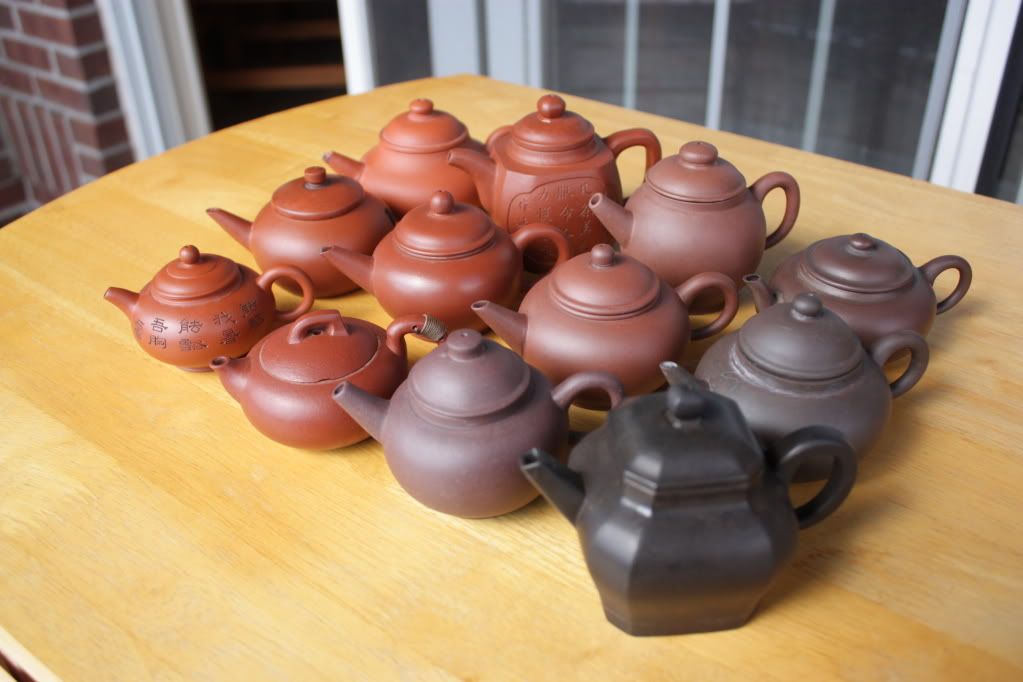
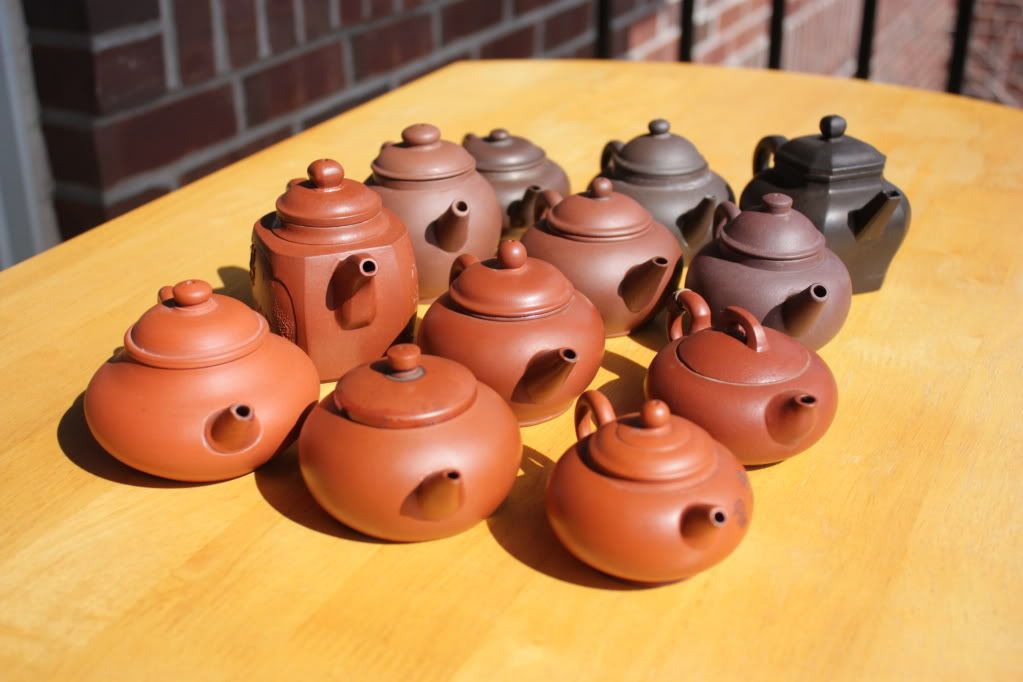
In order to make sense of colours and texture, there is unfortunately not many ways to do it other than looking at stuff. What do they mean when they say pig-liver, for example? Or vermillion, for that matter?
I tried here to show the range of possible colours from what I have on hand. We can leave duanni and the more exotic colours out of the picture, since most of them are probably not very natural anyway (blue, green, etc). I think pig liver is somwhere in the middle of the range here — one of the purplish/brown ones. Those, of course, don’t fall into the category of zhuni clay. So here there are six that I think obviously clear themselves out immediately for “zhuni” qualification. But then, you have the ones leftover
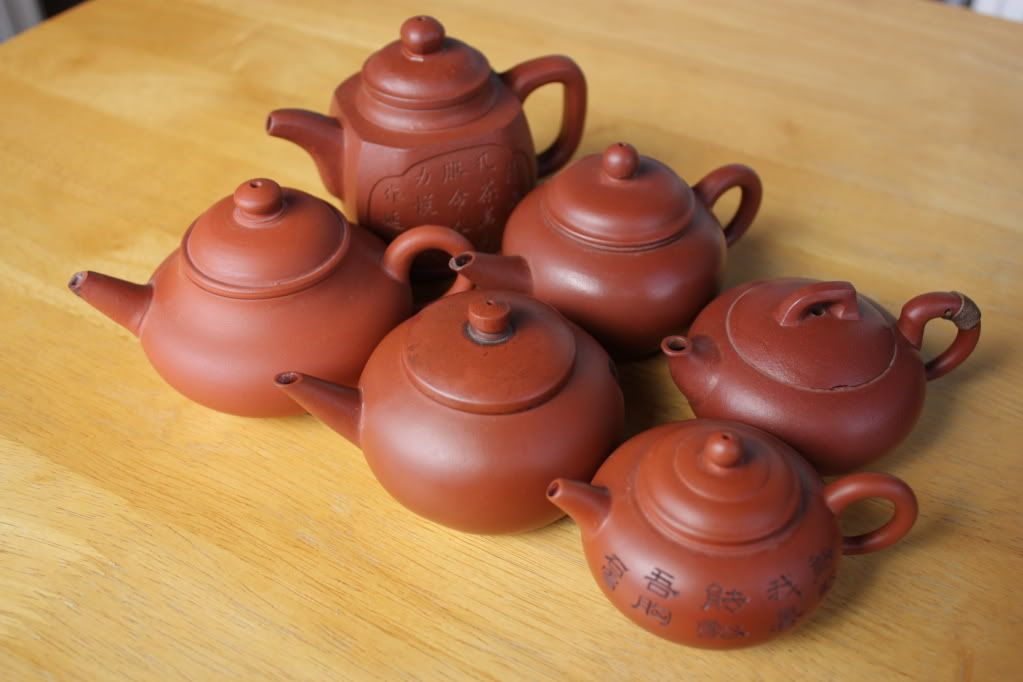
What about these?
Let’s label them one to six, with the front row (closer to us) being one to three, from left to right, and the back row being four to six. Number one here is actually a Tokoname, so that rules it out for zhuni status. Five and six are very new, with five being explicitly a hongni creation from a friend who commissioned the pot, and six being a pot that I bought brand new three years ago. So those are out, if we go by the theory that zhuni no longer exists, at least in terms of the Zhaozhuang mountain variety. That leaves two, three, and four.
Two is a pot I bought a while ago, broken. I posted about it then. I believe this is an actual zhuni pot of some vintage. I recently cleaned it, while leaving the lid in its original pre-cleaned condition. Some more pictures might explain better
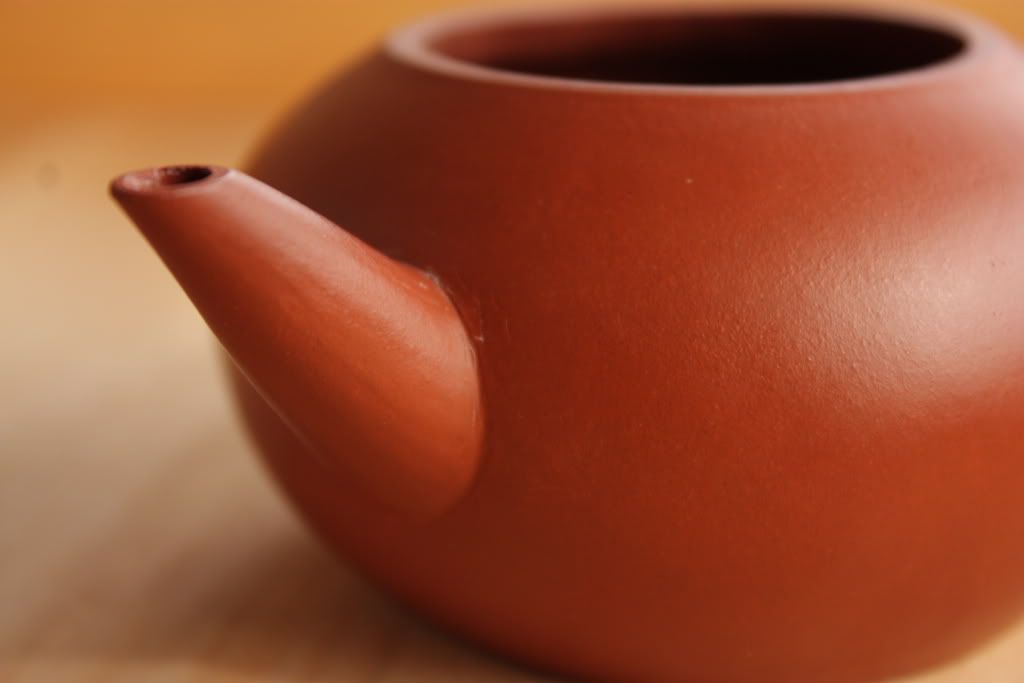
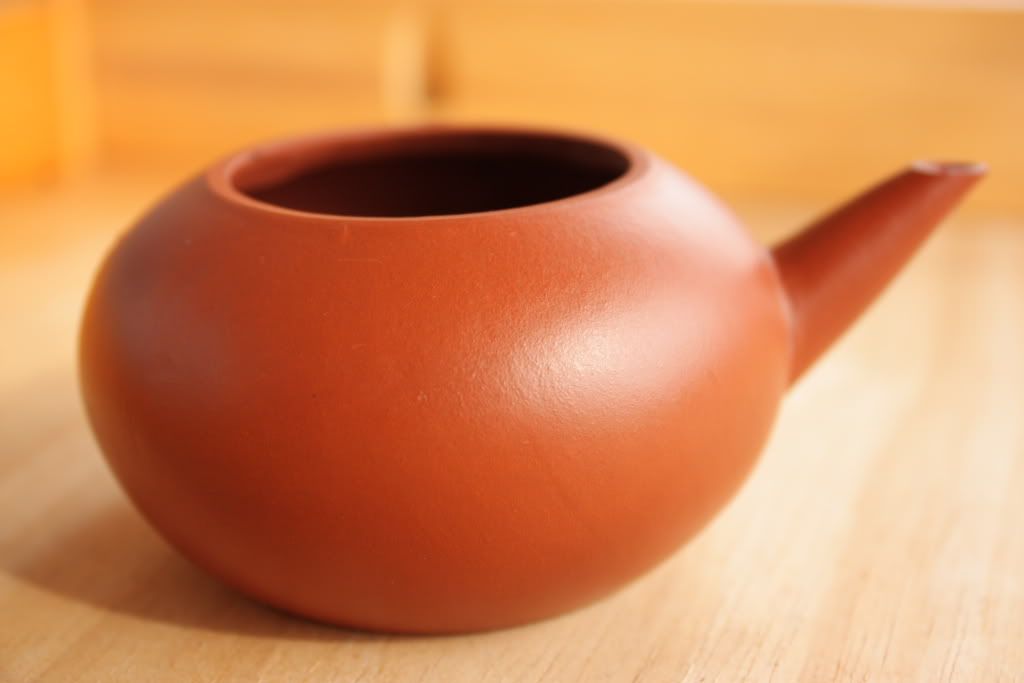
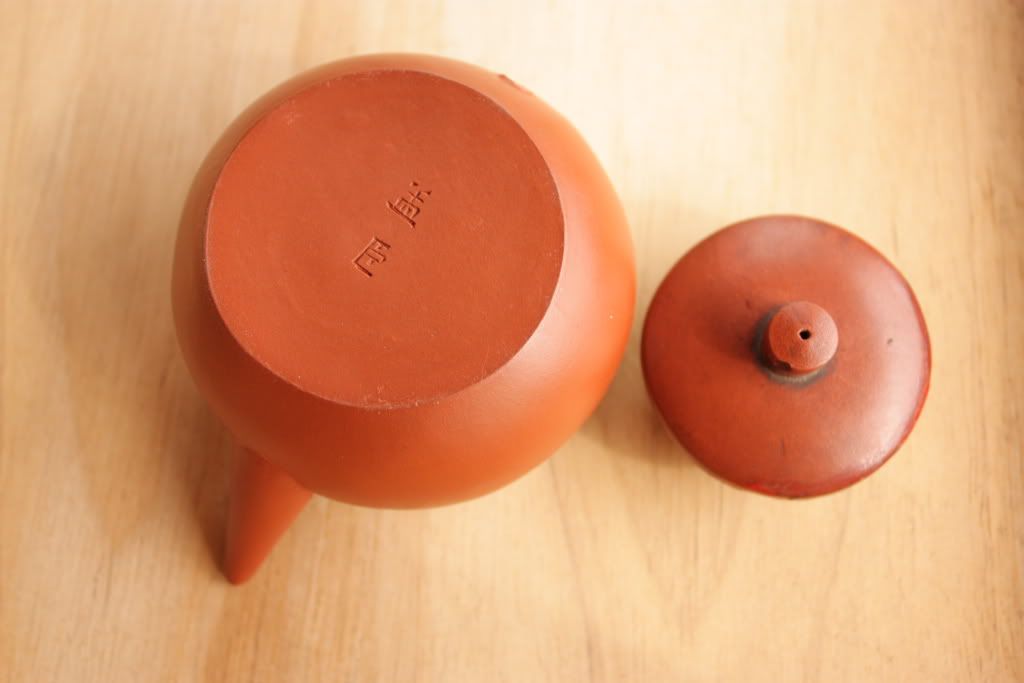
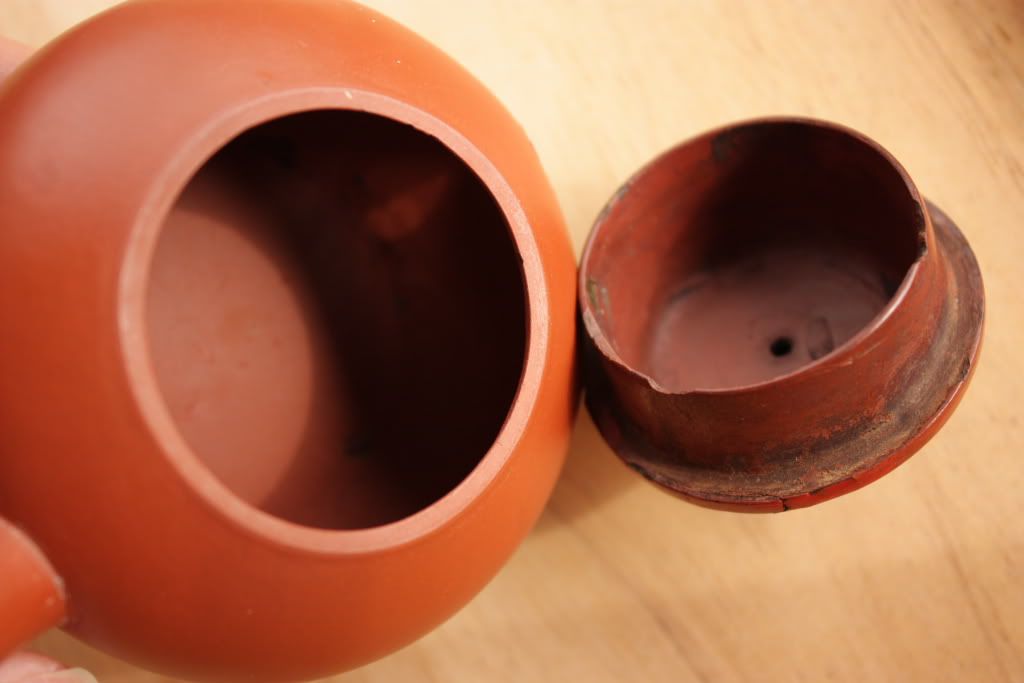
It is quite smooth, but not glassy. In toki’s words, feeling real zhuni is like feeling very fine sand. That, of course, depends on exactly what kind of mixture went into the pot, and may differ somewhat, but I’ve seen some purported zhuni pots that are very glassy. I don’t think those are the right ones, and are probably modern imitations/fake. It has a natural sheen before I’ve done anything to it — this is after some intense bleaching that got rid of any patina. It also has some shrink lines, but I think it’s also significant that the shrink lines are not that regular — I’ve seen pots with very regularly spaced shrink lines, which once again I think are a result of attempts to imitate zhuni behaviour.
Number three is very similar in clay to number two. It never struck me until I compared them side by side. I’ve always used that to make dark oolongs, and have had it for more than five years now. I bought this one used and for a not very cheap price, so perhaps this also qualifies?
Number four is more of a question mark. It is one of those that have large particles embedded in the clay. It certainly looks more convincing to me than the glassy “zhuni” pots, but is it real? I don’t know. This I purchased at the store where the owner has literally hundreds of purported old pots. Some look genuinely old. Others are a little more iffy. The jury’s out on this one.

 RSS - Posts
RSS - Posts
6 responses so far ↓
Anonymous // April 6, 2009 at 12:29 pm |
Is the year made really an accurate indicator though?
Zhuni was exported with the first tea’s and the English coveted them, since they were resistent to cracking from the hot water.
The chinese faked zhuni for export, and the english made copies since the late 1600’s. I saw a wedgewood “zhuni” at the chicago art museum that was quite convincing behind the glass.
To further confuse things, although the chinese government “closed/banned” the caves where zhuni was mined in the early 80’s, people still got it. Older potteries/potters also had old stock. Asian potters especially, recycle and age the clay before using it, by throwing it into like.. a pond, or burying it in a marsh. Often large amounts of clay are done at one time, and a family of potters will use that clay for generations. In some potter families, you only use the clay your grandfather buried. Any potter will attest that aged clay is just better to work with. Bacteria/fungi, etc grow in it, and make working the clay much much easier. You also have to remember that “clay” is not pure. It runs in veins of different consistencies. So all clays are blends because there’s no pure source, and blending is usually necessary to get a body that is suitable for use. That’s not even going into what happens when it’s water processed to separate it into layers.
I’m sure some of these stockpiles were sold/shared and others were adulterated by blending other clays in to make it workable, so who really knows if the clay source was “legit” unless they went to the mountain, and dug it up themselves without ever changing hands.
http://www.thepotteries.org/features/teapot.htm
MarshalN // April 6, 2009 at 12:52 pm |
Interesting link there.
The thing here though is that while we are talking about redware from China, there’s no indication at all that zhuni is the object concered here. It seems to be just any plain old red clay. I’m sure there were plenty of redware being exported, but if, say, Desaru shipwreck recovered pots are any indication, by and large they were various kinds of zisha clay rather than zhuni. Zhuni is also probably the most fragile among Yixing clays — it cracks easily compared to the others, so once again, I’m not sure if the clay in question is really zhuni at all.
Of course all clays are blended. I’m not disputing that at all, and have said a few times already that a lot depends on the formula used to blend/work the clay before firing. These are usually family secrets and we have no idea what goes on there.
Anonymous // April 6, 2009 at 3:26 pm |
I guess the practical question then would be can you taste a difference between what you are sure is hongni vs what you think is zhuni?
The English prized yixing ware because it did not crack when putting in boiling water. I don’t know of any mention of them thinking that it made better tasting tea, but then… the tea of the time was not what we drink today either.
I will concede that a nice yixing pot does something to the tea, because it does seem to taste different from making the same tea in a gaiwan.
But unless the clay is really bad, how much different does one pot make? (assuming starting from either a clean pot or similarly seasoned pots).
Every time I watch that, I change my mind a little bit.
stump // April 6, 2009 at 7:12 pm |
Great pictures and gorgeous teapots to boot!
MarshalN // April 7, 2009 at 12:08 am |
@gabrielpeter –
Thanks 🙂
Teaperday // May 21, 2009 at 2:53 pm |
Here is my penny. The one without handle is from late Qing Dyn. Its lid probably isn’t original but from silmiar period. You may use it as a standard of Zuni from that period. A word about the first commemt. Zuni from early Qing isn’t the same thing as the one here. There is significant difference. In the group of six red ones, at least 3 are modern and one isn’t Yixing. I would like to see more pictures on the purple group if possible.
Thanks for posting!!!!